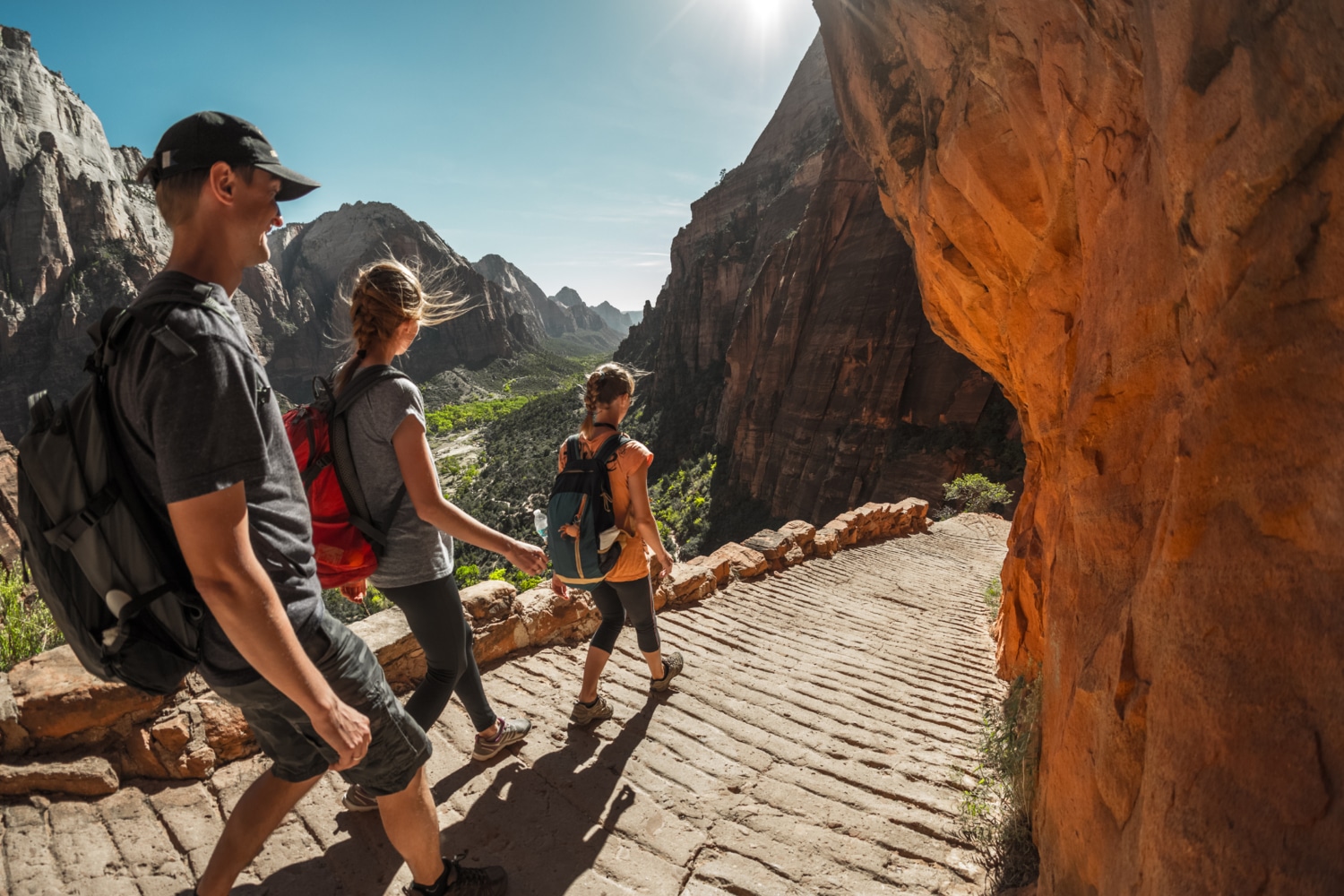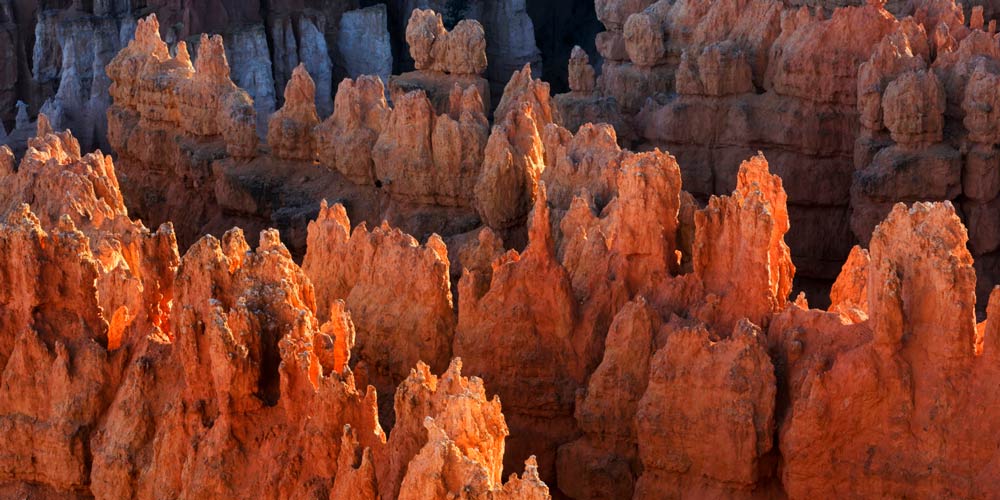Why Go
An other-worldly landscape made up of mysterious rock pillar hoodoos. Bryce Canyon National Park in southern Utah contains the largest expanse of these geological formations in the world. Located in southwest Utah, Bryce Canyon National Park is part of a scenic area of red rock canyons that make up the Grand Staircase-Escalante National Monument. Only 70 miles from Zion National Park, it’s easy to combine a family trip to see both Bryce and Zion National Parks.

What to Do
At roughly 36,000 acres, Bryce Canyon is one of the smaller National Parks in the country, but the compact region packs a high concentration of immense natural beauty. The main draw of Bryce is the amphitheater studded with strange and beautiful rock pillars with names like Thor’s Hammer, Queen Victoria and Goblin Valley. As the light changes throughout the day and seasons, the landscape shifts in the canyon to reveal new delights. It’s worth getting down amongst the hoodoos and experiencing them up close.
- Geology. It’s taken tens of millions of years to carve the landscape of Bryce Canyon National Park and the hoodoo rock spires are continually shaped by wind and water. If it’s your first visit, head to Sunset Point to take in the full beauty of Bryce Amphitheater. Listen to a knowledgable ranger talk about how the hoodoos are formed and walk the rim between Sunset and Sunrise Points.
- Camping. Bryce Canyon National Park has two campgrounds: North and Sunset Campgrounds. North Campground is close to the Visitor Center, while Sunset Campground is within walking distance to Bryce Amphitheater. Accomodations also available at the historic Bryce Canyon Lodge, established in 1925, adjacent to Sunrise Point. Campsites and hotel rooms go fast at Bryce Canyon National Park and can be booked up to a year ahead of time. You can also set up an RV at the Sunset Campground.
- Ranger and Jr. Ranger Programs. National Park Rangers answer questions and interpret the parks for curious kids. After setting up camp, hike over to Sunset Point for a Ranger Rim Walk. Rangers will give you a great introduction to Bryce Canyon and help adults and kids alike better understand the unique wonder of the largest expanse of hoodoos in the world. Other Ranger programs include geology talks, full moon hikes, astronomy programs and Jr. Ranger programs. At Bryce Canyon, Jr. Rangers must complete three tasks to get their official Jr. Ranger Badge. The tasks include: attending a Ranger hike or presentation, completing an activity book and picking up trash and litter to help keep the park pristine for future visitors.
- Hiking. The park guide bills the combined Queen’s Garden/Navajo Loop trails as the “best three-mile hike in the world.” It lives up to the hype. If you can do only one hike at Bryce Canyon National Park, do this one. Hopefully, you can do more too. Getting down to the valley floor among the hoodoos makes you feel as though you were transported back in time to ancient Babylon, or to another world altogether on a desolate alien planet. You will find a wide variety of hikes in Bryce from the paved one mile between Sunrise and Sunset Points that is wheelchair accessible to the eight-mile Fairyland Loop trail in a more remote area of the park.
- Horseback Riding. For a different way to experience the park, take a ride. Concessioners offer two- and four-hour guided horse and mule rides along the Peek-a-Boo Loop Trail in Bryce Canyon. Registration for the rides takes place at Bryce Canyon Lodge. Horseback riding is limited to specifically designated “Horse Trails.”
- Wildlife. There’s abundant wildlife (over 59 species of mammals alone) in Bryce Canyon National Park. In fact, deer strolling through your campsite is a regular occurrence. In addition to deer, Rocky Mountain Elk and Pronghorn cross the boundaries of the park. Utah Prairie Dogs are auburn colored burrowing rodents that are celebrated with a festival each April. Bird lovers have spotted over 200 different species of birds throughout the year in Bryce Canyon National Park.
- Astronomy and Stargazing. Bryce Canyon’s remote location, far from the light pollution of cities, is a dark sky sanctuary – meaning it is an ideal place for stargazing. Rangers lead astronomy programs with telescopes multiple times each week and there is a planisphere program offered during the day to orient visitors to the night sky. In late June, astrophysicists and potential physicists gather at Bryce Canyon National Park for an annual Astronomy Festival.

Getting Around
Like many National Parks, Bryce Canyon is in a remote region of the United States. Having a car is absolutely necessary to get there. The closest major airports are in Las Vegas or Salt Lake City, both of which are approximately 270 miles from the park. However, once you arrive in the park, you can park your car and take the shuttle to cut down on traffic and pollution. Shuttle buses are free and run from 8 am until 6-7 pm depending on the season. Shuttles arrive approximately every 15 minutes at each stop.
Dave Parfitt is a reformed academic with a PhD in neuroscience, who began writing about his family travel adventures after surviving a trip to Walt Disney World with his two budding princesses, now ages 19 and 16. As owner and editor of Adventures By Daddy, Dave offers family travel advice and escapist fun from Dad’s point of view.

